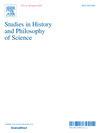How the cambrian exploded: Contingency in the history of science and life
IF 1.8
2区 哲学
Q1 HISTORY & PHILOSOPHY OF SCIENCE
引用次数: 0
Abstract
Few scientific terms are as colorful as the “Cambrian explosion”: the name given to the rapid increase in animal diversity and abundance between about 540 and 520 million years ago. But for all its popularity, considerable uncertainty surrounds the history of the expression. Discussions of explosive evolution date to the early twentieth century and gained in popularity during the 1940s. Still, these discussions did not emphasize— and many did not even mention— the Cambrian Period, instead focusing on later explosions as a means of characterizing a distinctive mode of evolutionary activity. So how did the Cambrian explosion come to overshadow all other evolutionary explosions to become “the Cambrian explosion”? And how have these developments shaped discussions of the nature and significance of the event? This paper examines these questions, beginning in the nineteenth century and focusing especially on the events of the twentieth century. In doing this it illuminates the contingent history of a term— and a set of ideas— that has played an outsized role in discussions of historical contingency in biology.
寒武纪是如何爆发的:科学史和生命史中的偶然性
很少有科学术语能像“寒武纪大爆发”那样丰富多彩。寒武纪大爆发指的是大约5.4亿至5.2亿年前动物多样性和数量的迅速增加。但是,尽管它很受欢迎,但它的历史却充满了不确定性。关于爆炸进化的讨论可以追溯到20世纪初,并在20世纪40年代开始流行。然而,这些讨论并没有强调——很多人甚至没有提到——寒武纪,而是把重点放在后来的大爆发上,把它作为描述一种独特的进化活动模式的手段。那么寒武纪大爆发是如何盖过其他所有进化大爆发而成为“寒武纪大爆发”的呢?这些发展又如何影响了对这一事件的性质和意义的讨论?本文考察了这些问题,从19世纪开始,特别关注20世纪的事件。在这样做的过程中,它阐明了一个术语的偶然性历史——以及一系列思想——在生物学历史偶然性的讨论中发挥了巨大的作用。
本文章由计算机程序翻译,如有差异,请以英文原文为准。
求助全文
约1分钟内获得全文
求助全文
来源期刊

Studies in History and Philosophy of Science
管理科学-科学史与科学哲学
CiteScore
2.50
自引率
10.00%
发文量
166
审稿时长
6.6 weeks
期刊介绍:
Studies in History and Philosophy of Science is devoted to the integrated study of the history, philosophy and sociology of the sciences. The editors encourage contributions both in the long-established areas of the history of the sciences and the philosophy of the sciences and in the topical areas of historiography of the sciences, the sciences in relation to gender, culture and society and the sciences in relation to arts. The Journal is international in scope and content and publishes papers from a wide range of countries and cultural traditions.
 求助内容:
求助内容: 应助结果提醒方式:
应助结果提醒方式:


